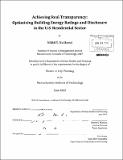| dc.contributor.advisor | Harvey G. Michaels. | en_US |
| dc.contributor.author | Nadkarni, Nikhil S. (Nikhil Sunil) | en_US |
| dc.contributor.other | Massachusetts Institute of Technology. Dept. of Urban Studies and Planning. | en_US |
| dc.coverage.spatial | n-us--- | en_US |
| dc.date.accessioned | 2012-10-10T15:48:45Z | |
| dc.date.available | 2012-10-10T15:48:45Z | |
| dc.date.copyright | 2012 | en_US |
| dc.date.issued | 2012 | en_US |
| dc.identifier.uri | http://hdl.handle.net/1721.1/73822 | |
| dc.description | Thesis (M.C.P.)--Massachusetts Institute of Technology, Dept. of Urban Studies and Planning, 2012. | en_US |
| dc.description | Cataloged from PDF version of thesis. | en_US |
| dc.description | Includes bibliographical references (p. 92-98). | en_US |
| dc.description.abstract | Residential energy efficiency in the U.S. has the potential to generate significant energy, carbon, and financial savings. Nonetheless, the market of home energy upgrades remains fragmented, and the number of homes being retrofitted remains insignificant compared to the volume of inefficient housing stock. Providing more complete information on the energy performance of homes can enable buyers and sellers to value energy efficiency and can catalyze the delivery of residential energy efficiency. To that end, the European Union and five cities in the U.S. and Australia have implemented, in recent years, the use of residential building labeling to convey home energy performance to market stakeholders. The transparency provided through such building labeling has the potential to tear down common barriers to efficiency and to provide ways for owners, tenants, homebuyers, and lenders alike to engage in home energy efficiency. However, there are numerous concerns surrounding the current approaches to building labeling, and the methods in use today are highly heterogeneous, leading to significant uncertainty surrounding this emerging policy tool. In particular, this thesis describes how building labeling can be optimized for the delivery of residential energy efficiency, focusing specifically on the type of rating that could be used and on the approach to disclosing home energy performance. To achieve this, the thesis examines literature and provides case studies of four cities in the U.S. that have implemented residential energy labeling. These case studies provide insight into the shortcomings of approaches in use today, as well as a look at the beneficial methods utilized in each city. In conjunction, the thesis examines the approach the E.U. is using, the role of the private sector, and voluntary approaches in the U.S. Based on the approaches discussed in the literature and case studies, there are several key attributes that a well-designed building labeling program should have. One key determination is that a strong labeling policy should combine asset ratings (based on an on-site assessment) and operational ratings (based on billing data) to maximize the clarity, functionality, and comparability of labels. Additionally, a well-designed labeling policy should maintain privacy while facilitating information access to the right stakeholders at the right time. Drawing on these findings, this thesis proposes a new model of disclosing residential energy performance. The model, centered on web-enabled data analysis and access, has the potential to provide timely, consistent, and visible ratings to key market actors and, in turn, provide more complete information to residential markets on building efficiency. This approach also combines multiple data sources and requirements into a single platform, in order to streamline the rating and disclosure process. This model offers several advantages for catalyzing residential energy efficiency, as compared to existing approaches. | en_US |
| dc.description.statementofresponsibility | by Nikhil S. Nadkarni. | en_US |
| dc.format.extent | 98 p. | en_US |
| dc.language.iso | eng | en_US |
| dc.publisher | Massachusetts Institute of Technology | en_US |
| dc.rights | M.I.T. theses are protected by
copyright. They may be viewed from this source for any purpose, but
reproduction or distribution in any format is prohibited without written
permission. See provided URL for inquiries about permission. | en_US |
| dc.rights.uri | http://dspace.mit.edu/handle/1721.1/7582 | en_US |
| dc.subject | Urban Studies and Planning. | en_US |
| dc.title | Achieving real transparency : optimizing building energy ratings and disclosure in the U.S. residential sector | en_US |
| dc.title.alternative | Optimizing building energy ratings and disclosure in the U.S. residential sector | en_US |
| dc.type | Thesis | en_US |
| dc.description.degree | M.C.P. | en_US |
| dc.contributor.department | Massachusetts Institute of Technology. Department of Urban Studies and Planning | |
| dc.identifier.oclc | 811344810 | en_US |
